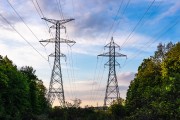We knew there was an inspiring story to tell when the Pembina Institute and GLOBE Series decided to profile the talented women whose work is transitioning Canada to a new energy future. But the broad scope of ways they’re addressing climate change is truly remarkable.
From speaking to these women, it’s clear that the energy transition is not just a problem of technology. A wide range of skills is needed, from designing policy, to making smart investments, to creating new workforce training programs. The women selected to be part of the Women in Energy Transformation project are working in every corner of the industry and taking on these new and innovative challenges.
Some, like Merran Smith, the executive director of Clean Energy Canada, have been working in the environmental sphere for decades. Smith’s early advocacy in conservation led to the protection of the massive Great Bear Rainforest protected area on British Columbia’s west coast.
Then she redirected her efforts. “We could protect forests and ecosystems, but climate change was really going to impact them so seriously,” she says, “so I decided to focus all my energy and passion on trying to address climate change.”
The work is diverse: from engineering, to financing, to research
P. Kim Sturgess, an engineer who is also the former president of the Canadian Academy of Engineering, is the founder and CEO of WaterSMART Solutions which supports sustainable economic development through better water management.
“Climate comes to ground in water,” says Sturgess. “You need healthy aquatic ecosystems, you need safe secure drinking water, and you need water for a sustainable economy. So that's where we are focused.”
Erin Flanagan, who is also an engineer, is the senior advisor for Responsible Investment and Climate Change at PSP Investments, one of Canada’s largest pension funds. Until recently, Flanagan was an environmental policy adviser for federal cabinet ministers and helped write the 2020 federal climate plan. Prior to that, she was also the federal policy director at the Pembina Institute.
Now is the time for Canada to find a place in the emerging green-energy economy, she says. “Otherwise, we risk being left behind. That’s why I think this is important and I think it's urgent that we sort this out now and we come together as a country around a shared vision.”
Those profiled in the Women in Energy Transformation project include academics who are studying renewable energy from multiple vantage points. Some spend their time developing new technologies to harness renewable energy. Some explore the social implications of energy development and transmission.
Bipasha Baruah, a professor and Canada Research Chair in Global Women’s Issues at Western University, examines ways that women and others who have been marginalized in the energy sector can be brought into the conversation as the world moves away from fossil fuels.
“I really want to see the benefits of that transition shared evenly by different groups of people in society,” says Baruah. “I want to see the transition happen in a way that is much more diverse than it's been in the past.”
Building bridges among government, industry, and Indigenous communities
Many of the women profiled spoke about the need to bring Indigenous management to renewable energy. In particular, many Indigenous women are taking the lead to empower their own community members, elevate their voices and concerns, and connect them with opportunities.And some are challenging the status quo.
Larissa Crawford, who is of Métis and Caribbean descent, founded Future Ancestors Services to bring an Indigenous worldview and perspectives of other minority communities to the energy discussion.
“The physical consequences of environment and climate change cannot be removed from the social and political implications and causes,” says Crawford, “and this is where I really focus my work.”
Others are working with governments, or inside governments, to effect change. And some are employed by the oil and gas industry as those companies adapt to the necessity of a cleaner future.
Arlene Strom, chief legal officer and general counsel for Suncor, spent years as the company’s vice president responsible for Aboriginal engagement, among other things. During that time, says Strom, “I became increasingly passionate about how we could contribute, in the energy industry, to an energy transition and to dealing with climate, and to dealing with reconciliation with Indigenous peoples.”
Join the Pembina Institute and GLOBE Series on November 24th for an interactive discussion of barriers and opportunities for women in the energy transition with Canada’s women leading on climate, including Bipasha Baruah (Western University) featured in this story.






